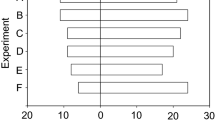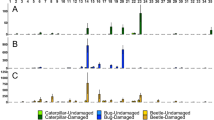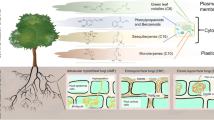Abstract
Animal biologists have recently focused on individual variation in behavioral traits and have found that individuals of many species have personalities. These are defined as consistent intraspecific differences in behaviors that are repeatable across different situations and stable over time. When animals sense danger, some individuals will alert neighbors with alarm calls and both calling and responding vary consistently among individuals. Plants, including sagebrush, emit volatile cues when they are attacked by herbivores and neighbors perceive these cues and reduce their own damage. We experimentally transferred volatiles between pairs of sagebrush plants to evaluate whether individuals showed consistent variation in their effectiveness as emitters and as receivers of cues, measured in terms of reduced herbivore damage. We found that 64% of the variance in chewing damage to branches over the growing season was attributable to the identity of the individual receiving the cues. This variation could have been caused by inherent differences in the plants as well as by differences in the environments where they grew and their histories. We found that 5% of the variance in chewing damage was attributable to the identity of the emitter that provided the cue. This fraction of variation was statistically significant and could not be attributed to the environmental conditions of the receiver. Effective receivers were also relatively effective emitters, indicating consistency across different situations. Pairs of receivers and emitters that were effective communicators in 2018 were again relatively effective in 2019, indicating consistency over time. These results suggest that plants have repeatable individual personalities with respect to alarm calls.



source of volatile cues for 10 different receiver plants. Cues from emitter plants were collected after experimentally clipping the branch


Similar content being viewed by others
Data availability
Data will be archived at Dryad Data (https://doi.org/10.5061/dryad.cfxpnvx6g).
References
Alpi A, Amrhein N et al (2007) Plant neurobiology: no brain, no gain? Trends Plant Sci 12:135–136
Bell AM, Hankison SJ, Laskowski KL (2009) The repeatability of behaviour: a meta-analysis. Anim Behav 77:771–783
Blumstein DT, Verneyre L, Daniel JC (2004) Reliability and the adaptive utility of discrimination among alarm callers. Proc R Soc B 271:1851–1857
Boake CRB (1994) Quantitative genetic studies of behavioral evolution. University of Chicago Press, Chicago
Bolnick DI, Svanback R, Fordyce JA, Yang LH, Davis JM, Hulsey CD, Forister ML (2003) The ecology of individuals: Incidence and implications of individual specialization. Am Nat 161:1–28
Brooks ME, Kristensen K, van Benthem KJ, Magnusson A, Berg CW, Nielsen A, Skaug HJ, Maechler M, Bolker BM (2017) glmmTMB balances speed and flexibility among packages for zero-inflated generalized linear mixed modeling. R Journal 9:378–400
Brown GE, Elvidge CK, Ramnarine I, Chivers DP, Ferrari MCO (2014) Personality and the response to predation risk: effects of information quantity and quality. Anim Cogn 17:1063–1069
Caro TM (2005) Antipredator defenses in birds and mammals. University of Chicago Press, Chicago
Chamovitz DA (2018) Plants are intelligent: now what? Nature Plants 4:622–623
Cheney DL, Seyfarth RM (1988) Assessment of meaning and the detection of unreliable signals by vervet monkeys. Anim Behav 36:477–486
Cook CW, Stoddart LA (1960) Physiological responses of big sagebrush to different types of herbage removal. J Range Manag 13:14–16
Coppinger BA, de Launay AS, Freeberg TM (2018) Carolina chickadee (Poecile carolinensis) calling behavior in response to threats and in flight: Flockmate familiarity matters. J Comp Psychol 132:16–23
Couchoux CJ, Clermont J, Garant D, Reale D (2018) Signaler and receiver boldness influence response to alarm calls in eastern chipmunks. Behav Ecol 29:212–220
Crutsinger GM, Collins MD, Fordyce JA, Gombert Z, Nice CC, Sanders NJ (2006) Plant genotypic diversity predicts community structure and governs an ecosystem process. Science 647:966–968
Dall SRX, Houston AI, McNamara JM (2004) The behavioural ecology of personality: consistent individual differences from an adaptive perspective. Ecol Lett 7:734–739
De Kroon H, Huber H, Stueber JF, van Groenendael JM, JM (2005) A modular concept of phenotypic plasticity in plants. New Phytol 166:73–82
De Moraes CM, Mescher MC, Tumlinson JH (2001) Caterpillar-induced nocturnal plant volatiles repel conspecific females. Nature 410:577–580
Dicke M, Sabelis MW (1988) How plants obtain predatory mites as bodyguards. Netherlands J Zool 38:148–165
Dochtermann NA, Schwab T, Sih A (2015) The contribution of additive genetic variation to personality variation: heritability of personality. Proc R Soc B 282:20142201
Falconer DS, Mackay TFC (1996) Introduction to quantitative genetics, 4th edn. Longman, New York
Frost CJ, Appel HM, Schultz JC (2007) Within-plant signalling via volatiles overcomes vascular constraints on systemic signalling and primes responses against herbivores. Ecol Lett 10:490–498
Hare JF, Atkins BA (2001) The squirrel that cried wolf: reliability detection by juvenile Richardson’s ground squirrels (Spermophilus richardsonii). Behav Ecol Sociobiol 51:108–112
Hasson O (1991) Pursuit-deterrent signals: communication between prey and predator. Trends Ecol Evol 6:325–329
Heil M, Adame-Alvarez M (2010) Short signaling distances make plant communication a soliloquy. Biol Let 6:843–845
Heil M, Karban R (2010) Explaining evolution of plant communication by airborne signals. Trends Ecol Evol 25:137–144
Herrera CM (2009) Multiplicity in unity. University of Chicago Press, Chicago
Holopainen JK, Blande JD (2013) Where do herbivore-induced volatiles go? Front Plant Sci 4:185
Hoogland JL (1996) Why do Gunnison’s prairie dogs give anti-predator calls? Animal Behviour 51:871–880
Ishizaki S, Kubota S, Shiojiri K, Karban R, Ohara M (2010) Development of eight microsatellite markers in big sagebrush (Artemisia tridentata Nutt). Mol Ecol Resour 10:232–236
Johnson MT, Lajeunesse MJ, Agrawal AA (2006) Additive and interactive effects of plant genotypic diversity on arthropod communities and plant fitness. Ecol Lett 9:24–34
Kaiser MI, Muller C (2021) What is an animal personality? Biol Philosophy 36:1
Karban R, Maron J (2002) The fitness consequences of interspecific eavesdropping between plants. Ecology 83:1209–1213
Karban R, Yang LH (2020) Feeding and damage-induced volatile cues make beetles disperse and produce more even distribution of damage for sagebrush. J Anim Ecol 89:2056–2062
Karban R, Shiojiri K, Huntzinger M, McCall AC (2006) Damage-induced resistance in sagebrush: volatiles are key to intra- and interplant communication. Ecology 87:922–930
Karban R, Ishizaki S, Shiojiri K (2012) Long-term demographic consequences of eavesdropping for sagebrush. J Ecol 100:932–938
Karban R, Wetzel WC, Shiojiri K, Ishizaki S, Ramirez SR, Blande JD (2014a) Deciphering the language of plant communication: volatile chemotypes of sagebrush. New Phytol 204:380–385
Karban R, Yang LH, Edwards KF (2014b) Volatile communication between plants that affects herbivory: a meta-analysis. Ecol Lett 17:44–52
Kessler A, Baldwin IT (2001) Defensive function of herbivore-induced plant volatile emissions in nature. Science 291:2141–2144
Kessler A, Halitschke R, Diezel C, Baldwin IT (2006) Priming of plant defense responses in nature by airborne signaling between Artemisia tridentata and Nicotiana attenuata. Oecologia 148:280–292
Kost C, Heil M (2006) Herbivore-induced plant volatiles induce an indirect defence in neighboring plants. J Ecol 94:619–628
Lopes-Lutz C, Alviano DS, Alviano CS, Kolodziejczyk PP (2008) Screening the chemical composition, antimicrobial and antioxidant activities of Artemisia essential oils. Phytochemistry 69:1732–1738
Maynard Smith J (1965) The evolution of alarm calls. Am Nat 99:59–63
Moiron M, Laskowski KL, Niemela PT (2020) Individual differences in behaviour explain variation in survival: A meta-analysis. Ecol Lett 23:399–408
Queller DC, Goodnight KF (1989) Estimating relatedness using genetic markers. Evolution 43:258–273
Reale D, Gallant BY, LeBlanc M, Festa-Bianchet M (2000) Consistency of temperament in bighorn ewes and correlates with behaviour and life history. Anim Behav 60:589–597
Reale D, Reader SM, Sol D, McDougall PT, Dingemanse NJ (2007) Integrating animal temperament within ecology and evolution. Biol Rev 82:291–318
Reed-Guy S, Gehris C, Shi M, Blumstein DT (2017) Sensitive plant (Mimosa pudica) hiding time depends on individual and state. Peer J 5:e3598
Schuman MC, Barthel K, Baldwin IT (2012) Herbivory-induced volatiles function as defenses increasing fitness of the native plant Nicotiana attenuata in nature. eLife 1:e00007
Schuman MC, Allmann S, Baldwin IT (2015) Plant defense phenotypes determine the consequences of volatile emission for individuals and neighbors. eLife 4:04490
Sherman PW (1977) Nepotism and the evolution of alarm calls. Science 197:1246–1253
Sherman PW (1985) Alarm calls of Belding’s ground squirrels to aerial predators: nepotism or self-preservation? Behav Ecol Sociobiol 17:313–323
Shiojiri K, Karban R (2006) Plant age, communication, and resistance to herbivores: young plants are better emitters and receivers. Oecologia 149:214–220
Shiojiri K, Karban R (2008) Seasonality of herbivory and communication between individuals of sagebrush. Arthropod-Plant Interactions 2:87–92
Shiojiri K, Karban R, Ishizaki S (2009) Volatile communication among sagebrush branches affects herbivory: timing of active cues. Arthropod-Plant Interactions 3:99–104
Sih A, Bell AM, Ziemba RE (2004) Behavioral syndromes: an integrative overview. Q R Biol 79:241–277
Sih A, Cote J, Evans M, Fogarty S, Pruitt J (2012) Ecological implications of behavioral syndromes. Ecol Lett 15:278–289
Simon FW, Hodson CN, Roitberg BD (2016) State dependence, personality, and plants: Light-foraging decisions in Mimosa pudica (L.). Ecol Evol 6:6301–6309
Smith BR, Blumstein DT (2008) Fitness consequences of personality: a meta-analysis. Behav Ecol 19:448–455
Stamps JA (2007) Growth-mortality tradeoffs and ‘personality traits’ in animals. Ecol Lett 10:355–363
Stoffel MA, Nakagawa S, Schielzeth H (2017) rptR: repeatability estimation and variance decomposition by generalized linear mixed-effects models. Methods Ecol Evol 8:1639–1644
Townsend SW, Rasmussen M, Manser MB (2012) Flexible alarm calling in meerkats: the role of the social environment and predation urgency. Behav Ecol 23:1360–1364
Turlings TCJ, Tumlinson JH, Lewis WJ (1990) Exploitation of herbivore-induced plant odors by host-seeking parasitic wasps. Science 250:1251–1253
Wetzel WC, Kharouba HM, Robinson M, Holyoak M, Karban R (2016) Variability in plant nutrients reduces insect herbivore performance. Nature 539:425–427
Wilson DS, Clark AB, Dearstyne T (1994) Shyness and boldness in humans and other animals. Trends Ecol Evol 9:442–446
Wolf M, Weissing FJ (2012) Animal personalities: consequences for ecology and evolution. Trends Ecol Evol 27:452–461
Woods RD, Kings M, McIvor GE, Thornton A (2018) Caller characteristics influence recruitment to collective anti-predator events in jackdaws. Sci Rep 8:1–8
Acknowledgements
We thank Kate Laskowski and Andy Sih for insightful comments. This study was also greatly improved by our interactions with Denis Reale and Judy Stamps. We were supported by grants from the USDA (NC-7 and NE-2001) to RK, a Marie Curie postdoc grant 797898 to PGT, and a Fonds de Recherche du Quebec postdoc to CC.
Funding
We were supported by grants from the USDA (NC-7 and NE-2001) to RK, a Marie Curie grant 797898 to PGT, and a Fonds de Recherche du Quebec postdoc to CC.
Author information
Authors and Affiliations
Contributions
RK and CC designed the study, RK and PGT conducted the experiments, PGT and RK analyzed the data, and RK wrote the manuscript with input from PGT.
Corresponding author
Ethics declarations
Conflict of interest
Not available.
Ethics approval
Not available.
Consent for publication
Not available.
Additional information
Communicated by Diethart Matthies.
Rights and permissions
About this article
Cite this article
Karban, R., Grof-Tisza, P. & Couchoux, C. Consistent individual variation in plant communication: do plants have personalities?. Oecologia 199, 129–137 (2022). https://doi.org/10.1007/s00442-022-05173-0
Received:
Accepted:
Published:
Issue Date:
DOI: https://doi.org/10.1007/s00442-022-05173-0




